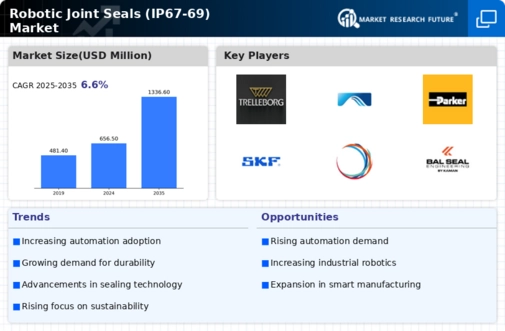The Robotic Joint Seals (IP67-69) Market, based on region, has been divided into North America, Europe, Asia Pacific, Middle East & Africa, and South America. North America consists of US, Canada, and Mexico. Europe consists of UK, Germany, France, Italy, and Rest of Europe. Asia-Pacific consists of China, India, Japan, and Rest Of Asia-Pacific. Middle East & Africa consists of Saudi Arabia, South Africa, UAE, and Rest of Middle East & Africa. South America consists of Brazil, Argentina, and Rest of South America. Asia-Pacific accounted for largest market share in 2023.
The countries in Asia Pacific region includes China, India, Japan, and rest of Asia Pacific.
The robotic joint seals (IP 67-69) market in Japan, China, and India is driven by rapid industrialization, technological advancement and expanding manufacturing industry. Japan, renowned for its precision engineering and advanced manufacturing capabilities, presents a robust for robotic joint seals (IP 67-69) market. With a focus on automation in sectors such as automotive, electronics, and healthcare, demand for high-performance robotic joint seals has increased significantly. As the world's largest manufacturing hub, China experiences significant demand for industrial automation solutions, including robotic joint seals.
Factors such as the adoption of Industry 4.0 technologies, expansion in automotive production, and growth in electronics manufacturing fuel the demand for reliable sealing solutions to ensure the longevity and performance of robotic systems. India, while emerging as a prominent player in the global manufacturing landscape, presents a distinct set of dynamics for the robotic joint seals (IP 67-69) market.
Europe accounted for the second largest market share in 2023. Robotic joint seals (IP 67-69) market, with their ability to protect critical connections in robotic systems from dust, water, and other environmental factors, play a vital role in ensuring the efficient and durable operation of robotics across various industries. The dynamics of robotic joint seals (IP 67-69) market, particularly in Germany, France, the UK, and Italy, are influenced by various factors.
Germany stands out as a powerhouse in automation and robotics, boasting a robust manufacturing industry and a strong emphasis on innovation. The German market for robotic joint seals is driven by the demand for high-quality seals that can withstand the rigorous operating conditions prevalent in advanced manufacturing facilities. In France, robotic joint seals (IP 67-69) market is influenced by the country's diverse industrial base, spanning sectors such as automotive, aerospace, and electronics. In the UK, with the growing adoption of automation in sectors such as logistics, healthcare, and food processing, there is an increasing demand for robotic joint seals.
Moreover, advancements in materials science and engineering contribute to the development of seals capable of meeting the IP ratings required for demanding applications.
The robotic joint seals (IP 67-69) market in the United States, Canada, and Mexico is influenced by a combination of technological advancements, industrial automation trends, and the overall economic landscape of these countries. These factors contribute to the dynamics shaping the demand, supply, and adoption of robotic joint seals across the North America region. In the United States, the robotic joint seals (IP 67-69) market is driven by several key factors. The country has a mature and advanced manufacturing sector, which extensively employs industrial robots for various applications, like automotive manufacturing, aerospace, healthcare, and pharmaceuticals.
In Canada, similar market dynamics influence the demand for robotic joint seals (IP 67-69) market.
The country's industrial landscape, though smaller in scale compared to the United States, encompasses diverse sectors such as energy, automotive manufacturing, and pharmaceuticals, all of which utilize robotic systems in various capacities. In conclusion, the robotic joint seals (IP 67-69) market in North America is shaped by a combination of factors. As automation continues to proliferate across various sectors in North America, the demand for robotic joint seals (IP 67-69) market, driving further innovation and market growth in the years to come.
The Robotic Joint Seals (IP67-69) Market, particularly those meeting IP 67-69 standards, in Brazil, Argentina, and the rest of South America is experiencing significant growth driven by several key dynamics. Ongoing advancements in manufacturing technologies have enabled the development of more durable and efficient robotic joint seals (IP 67-69) market. Manufacturers are leveraging innovations such as advanced elastomers and precision molding techniques to enhance the performance and reliability of these seals, thereby driving market growth. With the rising adoption of automation across various industries, the demand for robotic joint seals has escalated.
The South America market for robotic joint seals with IP 67-69 standard is characterized by intense competition among both domestic and international players. The rest of South America, encompassing countries such as Chile, Colombia, and Peru, exhibits varying degrees of potential for robotic joint seals (IP 67-69) market.
The Robotic Joint Seals (IP 67-69) market in South Africa, Saudi Arabia, and the UAE is expected to witness significant growth in the coming years, driven by several key factors. The growing adoption of automation across various industries, particularly in manufacturing, processing, food and beverage, and construction, is a significant driver for the Robotic Joint Seals (IP 67-69) market. As industries strive to improve efficiency and productivity, the demand for industrial robots is rising, which in turn, increases the need for robust joint seals with IP 67-69 standards to protect these robots from harsh operating environments.
The increasing demand for advanced technologies, such as collaborative robots (cobots) and Internet of Things (IoT)-enabled robots, is further propelling the market growth.
Figure 2: Robotic Joint Seals (IP67-69) Market Size By Region 2023 & 2032 (USD Million)

Source: Secondary Research, Primary Research, Market Research Future Database, and Analyst Review



















Leave a Comment